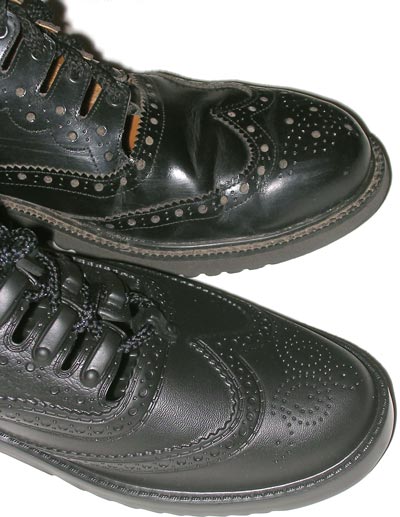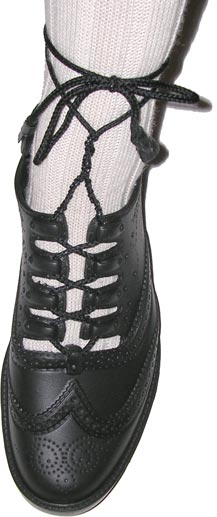  |
||
 |
 |
 |
 |
 |
||
| reference articles | competition journal | piping links | FAQ | contact me |
Andrew's Tips: Ghillators Ghillie Brogues ReviewBy Andrew T. Lenz, Jr., Santa Cruz, California, ©2009-2011
In October 2009, a new alternative ghillie brogue sprang on the market. Ghillators, invented by Jeff Anderson, can be summed up in three words: Ghillie Brogue Crocs. (For the few who don’t recognize the brand name “Crocs”, they are those molded synthetic vented shoes which have hit it big in in the last few years.) Anyone who has worn ghillie brogues is aware that they typically range from tolerable to painful. And we’ve all experienced firsthand or heard the horror stories about the blistered feet after a long highland games or parade. Jeff Anderson is no stranger to the pipe band scene. He’s a SUSPBA adjudicator and also chairs the SUSPBA Music Board. He also has been the SUSPBA delegate for the music initiatives committee of ANAPBA and has participated in at least five ANAPBA summits, including two hosted by WUSPBA in 2007 and 2011. Driven by personal experience of wearing brogues in foul weather only to have them fall apart or wearing other very uncomfortable pairs, he figured it was time for another option. I asked Jeff about his inventive spirit. “I am a pharmacist and formulated an antimicrobial pipe bag seasoning for hide bags years ago. However, I never really advanced with the concept or marketed my idea because synthetic pipe bags seemed to monopolize the market. I did not see strong market potential. However, Ghillators are a different story. “In my current role as a hospital pharmacy director, I am frequently developing and creating methods to improve processes without compromising safety or integrity. Relating this to the development of Ghillators, I recognized a need to improve traditional ghillie brogues . . . to make them more comfortable and easier to keep clean. I scoured the market looking for materials that could be fashioned to look like the traditional ghillie brogue and still maintain the ghillie brogue’s distinctive appearance. I knew that comfy, clean, and classically designed ghillies would appeal to kilt wearing aficionados worldwide! With this ambition and drive, I assembled a team to make Ghillators a reality.” In late Spring 2009, the first prototype Ghillators were in the hands of Jeff’s bandmates, friends and colleagues. After a number of months and a series of improvements to the prototype, the new shoes were in mass production. According to the website, “Ghillators ghillie brogues feature closed-cell resin, elastomeric polymers. This substantial innovation in footwear produces the first comfortable, lightweight, cleanable, and odor-resistant.” The shoes currently retail at “an introductory price” of $49.95, compared to $80 or more for a traditional pair. I had high hopes for the comfort factor but I was mostly concerned about the appearance since the photos on the Ghillators website were rather dark and small. I ordered a pair of Ghillators in October and they shipped from Florida to California in 2 days via U.S. Priority Mail. The box arrived surprisingly light. I gave a shoe to my 11-year-old daughter Charlotte to hold in her hand and her response was “Wow! Those are light!” (A digital scale backs that up, they weigh less than half the weight of even a light-weight true ghillie brogue.) She also told me that they smell like Crocs; she would know since she had such a pair. It’s not a bad or strong smell, just the type of odor. The Ghillators are ever so slightly lighter in color than expected, just a touch more gray than a saturated black, but it’s not particularly noticeable. They are also more matte and do not have the polished look; this is more apparent. The laces pass through the shoe in a significantly different manner than a typical brogue. The laces don’t pass from below like a typical shoe, but pass horizontally through a tiny “block.” But again, without looking close, it’s not going to be noticed. Considering that back in my early days I never had a judge comment on my black walking shoes with the tongue cut out, you are going to be very safe at a competition with these! Again, at a glance no one will tell the difference.
Ghillators come in 8-1/2, 9-1/2, 10-1/2, 11-1/2, and 12-1/2 US/Canada sizes. [In September 2010, sizes down to 6-1/2 and up to 13-1/2 were added.] (There is a chart on the Ghillators website for conversion to women, UK, Mexican, and other size systems.) My feet fit shoes a size somewhere around 9-1/2 and 10. Being that kilt hose can be thick (I have a pair of cabled hose) I opted for a size 10-1/2. I tried on the Ghillators with a thinner pair of hose and found them uncomfortably tight. I then tried them with white gym socks and still found them constricting. I contacted Jeff and, as per his policy, he was very gracious about having them exchanged for the next size up. The 11-1/2 size fits just fine. Jeff says that he’ll be expanding the available sizes (including more to fit women’s feet) and also adjusting the shoe size assignments for the next production run and these should be readily available by mid-2010. In the meantime, it’d be wise to discuss ordering a size or two bigger than what you might otherwise think. [I spoke with Jeff in 2011 and he said that he opted to keep the shoes sizes the same—if small—rather than risk confusing things further.] While I didn’t have a highland games or parade to attend, I did wear the shoes around the house for about eight hours. Not quite as comfortable as slippers but dramatically more easy on the feet than a typical ghillie brogue shoe. Yes, these shoes are comfortable. One thing that was unmistakable is that your feet will sweat more in these polymer shoes. For the vast majority of people this will not be a concern, but, as was pointed out to me, some pipers have skin problems which might keep Ghillators from being a good choice. The Ghillator website warns of pulling the laces tight. I read online that a piper in New Jersey gave the laces a good yank and broke the top lace holder, so there is a good reason for the warning. A gentle hand is required. If I were to play in foul weather or was expecting mud, there’s no question which pair of shoes I’d grab. Ghillators you can submerge in the kitchen sink, scrub with a sponge and throw on a drying rack. That said, personally, I wouldn’t wear them with a Prince Charlie outfit. As for a games on a nice day, it depends if you want that incremental improvement in shoe appearance. The Ghillators are almost certainly going to be more comfortable than what you’re used to. So, bottom line? Downsides: matte finish, somewhat sweaty feet, have to take it easy when tying, sizing can be an issue. Upsides: incredibly light, comfortable, super easy to clean, inexpensive. For more information, visit: Ghillators.com [This review first appeared in its original form in the Fall 2009 issue of WUSPBA Words & Music.] If you have comments or suggestions about this page, please contact me. This page last updated Friday, March 25, 2011. |
| sitemap | ||



